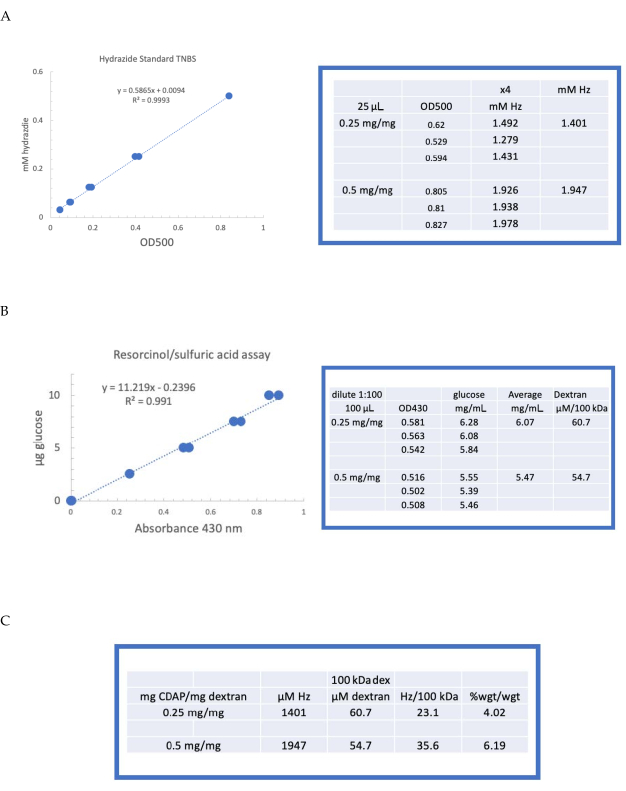Abstract
Immunology and Infection
Activering en conjugatie van oplosbare polysacchariden met behulp van 1-cyano-4-dimethylaminopyridinetetrafluorboraat (CDAP)
ERRATUM NOTICE
Important: There has been an erratum issued for this article. Read more …Geconjugeerde vaccins zijn opmerkelijke vooruitgangen in de vaccinologie. Voor de bereiding van polysaccharideconjugaatvaccins kunnen de polysacchariden gemakkelijk worden gefunctionaliseerd en gekoppeld aan vaccindragereiwitten met behulp van 1-cyano-4-dimethylaminopyridinetetrafluoroboraat (CDAP), een gemakkelijk te hanteren cyanylating-reagens. CDAP activeert polysacchariden door te reageren met koolhydraathydroxylgroepen bij pH 7-9. De stabiliteit en reactiviteit van CDAP zijn sterk pH-afhankelijk. De pH van de reactie neemt ook af tijdens activering als gevolg van de hydrolyse van CDAP, waardoor een goede pH-regeling de sleutel is tot reproduceerbare activering. Het oorspronkelijke CDAP-activeringsprotocol werd uitgevoerd bij kamertemperatuur in niet-gebufferde pH 9-oplossingen.
Vanwege de snelle reactie onder deze omstandigheden (<3 min) en de bijbehorende snelle pH-daling van de snelle CDAP-hydrolyse, was het een uitdaging om de pH van de doelreactie in het korte tijdsbestek snel aan te passen en te handhaven. Het verbeterde protocol dat hier wordt beschreven, wordt uitgevoerd bij 0 °C, wat de CDAP-hydrolyse vertraagt en de activeringstijd verlengt van 3 minuten tot ~ 15 minuten. Dimethylaminopyridine (DMAP) werd ook gebruikt als buffer om de polysaccharide-oplossing vooraf aan te passen aan de pH van de doelactivering voordat het CDAP-reagens werd toegevoegd. De langere reactietijd, in combinatie met de langzamere CDAP-hydrolyse en het gebruik van DMAP-buffer, maakt het gemakkelijker om de activerings-pH gedurende de gehele duur van het activeringsproces te handhaven. Het verbeterde protocol maakt het activeringsproces minder hectisch, reproduceerbaarder en vatbaarder voor opschaling.
Erratum
Erratum: Activation and Conjugation of Soluble Polysaccharides using 1-Cyano-4-Dimethylaminopyridine Tetrafluoroborate (CDAP)An erratum was issued for: Activation and Conjugation of Soluble Polysaccharides using 1-Cyano-4-Dimethylaminopyridine Tetrafluoroborate (CDAP). A figure was updated.
Figure 4 was updated from:

Figure 4: Representative results for CDAP activation of dextran. Typical standard curves for the (A) resorcinol/sulfuric acid and (B) TNBS assays. The assay results for dextran activated with 0.25 and 0.5 mg CDAP/mg dextran are shown. Glucose was used as the standard for the resorcinol assay. Dextran, in mg/mL, is divided by 100 kDa to give a molar concentration. The hydrazide concentration is determined using ADH as the standard and the results expressed as µM Hz. (C) Calculation of hydrazide: dextran ratios.The level of derivatization was calculated as hydrazides per 100 kDa of dextran to facilitate the comparison between polymers of different average molecular weights. The % weight ratio of g ADH/g dextran was calculated using a MW of 174 g/mole for ADH. Please click here to view a larger version of this figure.
to:

Figure 4: Representative results for CDAP activation of dextran. Typical standard curves for the (A) resorcinol/sulfuric acid and (B) TNBS assays. The assay results for dextran activated with 0.25 and 0.5 mg CDAP/mg dextran are shown. Glucose was used as the standard for the resorcinol assay. Dextran, in mg/mL, is divided by 100 kDa to give a molar concentration. The hydrazide concentration is determined using ADH as the standard and the results expressed as µM Hz. (C) Calculation of hydrazide: dextran ratios.The level of derivatization was calculated as hydrazides per 100 kDa of dextran to facilitate the comparison between polymers of different average molecular weights. The % weight ratio of g ADH/g dextran was calculated using a MW of 174 g/mole for ADH. Please click here to view a larger version of this figure.
ABOUT JoVE
Copyright © 2024 MyJoVE Corporation. All rights reserved